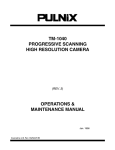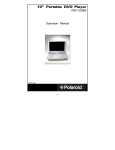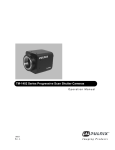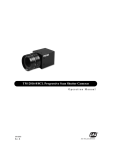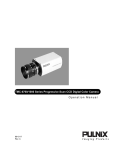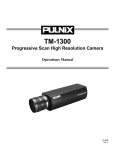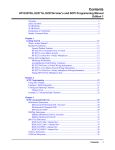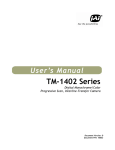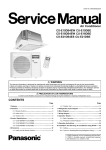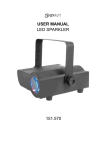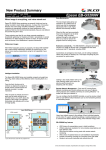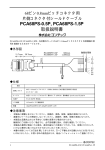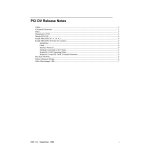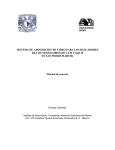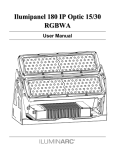Download User manual
Transcript
TM-1010 PROGRESSIVE SCANNING HIGH RESOLUTION CAMERA (REV. 2) OPERATIONS & MAINTENANCE MANUAL JUN 1996 Covered by U.S. Pat. # 6259478 B1 1.1 Features and Applications Frame memory and Digital output The TM-1010 has a built-in frame grabber and a frame memory. The 10-bit A/D converter provides 1024 gray levels with maximized signal-to-noise ratio. The output can be real time digital output or captured image (frozen picture). The digital output format is always progressive scan at the maximum rate of 15 frames / sec. and is RS-422 differential output. The TM-1010 is a state-of-the-art CCD camera which uses a 1 inch 1K x 1K progressive scan interline transfer CCD imager. This CCD camera offers outstanding compactness, high resolution, built-in frame memory, asynchronous reset and electronic shutter, 10-bit digital output as well as analog video and a number of technical innovations. The camera's various features allow for versatile applications, such as high resolution image capturing, machine vision, computer graphics, gauging, avionics, microscopy, medical imaging, character and fine pattern recognition, document reading and high end surveillance. Variable clock rate The standard pixel clock frequency is 20 MHz but TM1010 can be programmed to operate at 10 MHz and 5 MHz in ordet to adapt various higher bit frame grabbers which normally runs at slower speed for 10bit processing. Also, lower speed reduces the system noise to degree and increase sensitivity due to longer integration at the speed. Miniaturized and light weight All PULNiX cameras are built with the same design principles: Solid state technology; miniaturization; application specific such as custom design, remote imagers, special functions for various application needs; robust design even for military applications. Async image capturing The TM-1010 captures async reset image and provides continuous video output of the same image. It makes simpler for an ordinary frame grabber to capture the async reset images. Imager The TM-1010 uses a 1K x 1K progressive scan interline transfer CCD. The reason of such CCD is, 1. High resolution (1024 x 1024 active pixels) For very high resolution and image quality. 2. Square pixel (9.0 x 9.0 µm) Precise dimensional measurement ability. 3. High speed electronic shutter capability High dynamic resolution of moving object and electronic iris control. Eliminates a need of mechanical shutter. 4. Progressive scan Eliminates interlace deterioration of image. Ease of computer interface. 5. High sensitivity and low noise at fast scanning Can drive faster than 20 MHz x 2 pixel clock rate. (40 MHz output clock) Excellent S/N ratio (>50 dB). Micro lens built-in. Integration The TM-1010 is capable of capturing high resolution integration images. The integration can last from 1/15 sec to a few seconds. For uniform and low noise integration, PULNiX offers a peltier cooled CCD option. Analog output (interlace) Since 1K x 1K cameras are no longer in TV format, the display of the video signal is only achieved by using a frame grabber and computer or special monitor. The TM-1010 has a feature of analog display output for signal monitoring purpose from BNC connector but the signal is not processed for the scan conversion in order to maintain good S/N ratio. While the digital is 10-bit non-interlace, the analog is 8-bit non-interlace output. If analog display is important, PULNiX offers TM-1040. Asynchronous reset The TM-1010 can be reset with external reset pulse (VINIT).When VINIT is enabled at Async mode, the camera keeps discharging from CCD and with VINIT leading edge (negative going pulse), it resets the internal timing and starts integrating the image for the preset period of shutter timing and outputs the async shutter video. This feature is especially important to capture moving objects at the precise location of the field of view such as belt conveyer, fast event observation and still picture capturing. A/D reference voltage and dynamic range control 10-bit A/D converter’s reference voltage can be controlled by back panel switches or RS-232C. The high reference and low reference variation provides A/D or signal processing dynamic range to maximize CCD characteristics. Remote RS-232C copntrol The back panel mode switch, gain control, shutter speed, A/D reference functions and the data preset are controlled by RS-232C communication. NOTE: TM-1010 has a microlens CCD. 2 2. SPECIFICATIONS Imager Imager Total pixels Photosensitive pixels Photosensitive area Pixel size Output sensitivity Micro lens 1" Progressive scan interline transfer CCD 1024 (H) x 1024 (V) 1008 (H) x 1018 (V) 6 + 10 ob(H), 4 + 2 ob (V) 9.1 (H) x 9.2 (V) mm 9.0 (H) x 9.0 (V) µm 12 µV/eBuilt-in Blemish Point defect No defect <5 <10 <20 Class 0 Class 1 Class 2 Class 3 Cluster 0 0 <4 <8 Column 0 0 <2 <4 Peak quantum efficiency: 38% 1.0 O.9 TM-1001 0.8 0.7 Relative Sensitivity 0.6 0.5 0.4 0.3 TM-1000 0.2 0.1 0 300 400 500 600 700 800 900 1000 1100 Wave Length (nm) TM-1001 SPECTRAL RESPONSE Camera Scanning Sync Pixel clock TV resolution Minimum illumination S/N ratio Video output Display mode video AGC MGC Gamma Lens mount Power requirement Operating temperature Vibration and shock Size Weight Power cable Digital cable Power supply 1024 lines 15 Hz ( Single channel output from CCD, single channel output for read out) Internal / External auto switch HD / VD, 4.0 Vp-p impedance 4.7 KΩ fHD = 15.75 KHz fVD = 15 Hz 20.034 MHz, output clock: selectable 20 MHz, 10 MHz and 5 MHz Analog :700 (H) x 800 (V) , Digital: 1008 (H) x 1018 (V) pixel resolution 2.0 lux, f = 1.4 without IR cut filter 50 dB min. AGC = Off Analog 1.0 Vp-p composite video, 75 Ω , sync negative Digital 10-bit RS-422 differential output Data clock = 20.034 MHz (10 MHz, 5 MHz) Analog only fHD = 15.75 KHz, fVD = 15 Hz, Non-interlace Off Manual gain adjustable ( 6 dB to 26 dB ) 1.0 C-mount........1" lens format 12 V DC 500 mA (700 mA for driving RS-422) -10° C to 50° C Vibration: 7G (200Hz to 2000Hz), shock: 70G 51mm (H) x 67 (W)mm x 152mm (L) (2.01" x 2.64" x 5.98" ) 330 grams ( 11.6 oz ) 12P-02 30DG-02-10 (10-bit cable) K25-12V or PD-12 3 TM-1010 1K X 1K HIGH RESOLUTION ASYNCHRONOUS RESET FULL FRAME SHUTTER CAMERA The TM-1010 is designed to accommodate a high resolution, ON-LINE inspection reset mechanism with full frame shutter. It takes external horizontal sync to lock the camera and VINIT pulse for resetting the camera asynchronously. The shutter speed can be controlled by either an external double pulse or internal shutter speed control with a 10-position dial switch on the back panel. 1. Discharge Principle of CCD 1.1 Substrate Drain Shutter Mechanism Normal operation requires the CCD chip to construct an individual potential well at each image cell. The potential wells are separated from each other by a barrier. The barrier is sequentially removed to transfer the charge from one cell to another by pixel clock. This is the basic principle of the CCD operation for charge transfer. The substrate drain vertically moves the charges. When excess potential is applied to substrate underneath each cell, a potential barrier is pulled down to release the charge into the drain. This can happen to all the cells simultaneously, whereas normal CCD shuttering is achieved with a horizontal charge shift to the drain area by interline transferring or reverse transferring of the frame transfer chip. Photo cell potential distribution Surface CCD surface + Potential barrier Si substrate Vsub = normal mode Charge drain to substrate Vsub = shutter mode 1.2 Asynchronous shutter For Async Shutter mode, set jumper W5 of bottom board open and provide external Hd for phase locking. When the negative going reset pulse is applied, the camera will latch the falling edge to its next horizontal drive and reset vertical sync timing immediately. Therefore, the horizontal phase won't be interrupted. The TM-1010 asynchronous camera outputs a full frame of shuttered video in progressive scanning format from a frame buffer. The frame buffer is updated upon receiving negative reset pulse. ASYNC RESET VINIT VD SG (TRANSFER GATE) DISCHARGE PULSE PROGRESSIVE OUTPUT VIDEO OLD VIDEO IN MEMORY SHUTTER VIDEO 4 SAME VIDEO FROM FRAME MEMORY 2. Shutter Speed Control 2.1 External pulse width control mode X External Double pulse Hd Internal Vinit 9H Transfer Gate Pulse 9H X Exposure Time Discharge pulse Composite Video For External Pulse Mode, set dial switch to "9". Apply a pulse width control VINIT signal, which can be generated from an external event trigger, to the camera. Internal reset pulse will be latched to Hd and at 9th HD timing from external pulse leading edge ( negative going edge ), CCD discharge pulse is generated to clear the images. The internal VINIT is generated at the following edge ( positive going edge ) of the external pulse and it resets internal timing including the video sync. The shutter speed is the same as the external pulse width but the integration delays 9H from the leading edge. For immediate reset option, please contact PULNiX. One frame of video output will start from the rising edge of the pulse width control for progressive format. The camera will output the same video from memory when VINIT is kept high (5V) and update the image upon receiving next pulse. At async mode, with external pulse input high, the video output is disabled as the camera keeps discharging CCD image and only provides black video. 2.2 Internal Fast reset mode External pulse min. 2H Hd Internal Vinit 9H Transfer Gate Pulse Exposure Time Purge pulse (discharge) Composite Video 5 For Internal Fast Reset Mode, set the 10-position dial switch from "1" to "4". When fast reset mode is selected, the camera resets with internal VINIT timing, which is latched to Hd, and video output is also synchronized with internal VINIT timing without further delay. The shutter speed is controlled by the dial switch. 2.3 Internal Slow reset mode External pulse min. 2H Hd Internal Vinit 9H Transfer Gate Pulse 9H Discharge pulse EXPOSURE TIME Composite Video With the Internal Slow Reset mode selected, the camera operates the reset and shutter in the same means as the external Double Pulse mode. When external VINIT pulse is applied, internal VINIT is latched to Hd and the second internal VINIT signal is generated to set up the shutter speed period. The shutter speed is controlled by setting the dial switch from "5" to "8". Video output timing starts right after the second internal VINIT. For the timing of the second internal reset, LPULSE output of 31-pin connector can be used. 3. Top Board Layout and Adjustment Preset AGC MGC J1 W1 1 VR1 AGC 2.0 V 17 J4 W5 VR2 AGC MAX 1.5 V (22 dB) W6 VR5 VR3 No mount VR1 12 1 W3 VR2 VR4 No mount VR5 VR mechanical center ON J1 J3 W2 OFF 1 2 J2A 1 15 W8 W7 1 J8 18 TM-1010 SIGNAL BOARD TOP Jumpers W1 AGC/MGC W2 Gamma W3 Down load W4 CAL w5 - W8 MGC Set to 1.0 (OFF) Open for chassis GND Middle boards Layout and Adjustment TP1 VR1 J10 W5 W4 Preset VR2 PED VR1 W3 W2 W7 J5 W1 ON OFF VR2 11 1 20 10 W6 TM-1010 MEMORY BOARD BOTTOM 6 D/A reference Jumpers W1 Gamma W2 DL W3 ER W4 - W7 Set pedestal at 50 mV of video (analog) TBD (Vin = V out) Set to OFF Chassis GND 4. Bottom board Jumper XTAL W1 VR1 W9 W2 DC-DC W1 - W4 for chassis GND W9 5VDR W17 +10V adj Keep short Keep I side 1 TP1 Power supply selection J7 W17 10 W3 W4 J5 11 10 Select internal jumper W10 through W16 (back side) for power supply optimization. Potentiometer 20 1 VR1 PLL Set at mechanical center Ext. sync input impedance Jumpers W5 and W6 (back side) select for 75 Ω termination. When it is open (factory set), it is 4.7 KΩ (high impedance). TM-1010 POWER BOARD TOP 5. Digital output connector An EIA-422 digital output is available from 31-pin high-rel, micro-miniature connector (Airborn MP221-031-2432200). The mating connector can be firmly secured to the receptacle for vibration and shock environments. A common D-sub connector was not used to prevent any vibration problems. 1 16 31 17 6. Connector Pin Configurations C DE AB 5 DWN RS-232 F01 2 89 8 MODE 3 Gain selection (6 dB) “ (9 dB) “ (12 dB) “ (16 dB) Clock selection (20,10,5MHz) A/D Vref low A/D Vref high Freeze (ENINT) enable 4 POWER VIDEO DIGITAL External Vinit input or VD (TTL) Ext. HD sync input (TTL) Integration control input (TTL), active low Digital video output ( 10-bit ) " Mode control switch Normal mode MGC gain control Async / Manual shutter 34 5 67 UP 2 34 901 Description Pixel clock(20.034MHz) output " Line data valid " Field data valid " 6-1. 0 1 2 67 SHUTTER Pin No Signal 1 CLK+ 17 CLK2 LDV+ 18 LDV3 FDV+ 19 FDV4 GND 20 VINIT/VD 5 EXT. HD 21 INTEG. CONT 6 - 15 DO0+ - DO9+ 22 - 31 DO0 - - DO916 GND 5 6 7 8 9 A TM-1010 Back plate B-F Factory default recall User default (Default page at power up) Press Up and power on User page storage 7 Up/Down (6 to 22 dB) Up: Manual Down: Async Up to set Down Up Down Up/down Up/Down Up/Down Up: Real time Down: Freeze Up/down: recall factory default Up: save data (latest data) Down: Load user default data Calibration mode Up: save Down: Recall 9 1 2 3 11 12 4 SH CONTROL 8 10 9 0 1 7 8 7 6 5 2 3 6 5 4 12-PIN Connector 1. GND 7. VD In 2. +12V DC 8. GND 3. GND 9. HD In 4. Video Out 10. GND 5. GND 11. Integration Control 6. VINIT In 12. GND NOTE: TM-9700, TM-540, TM-720, TM-745, TM-1001 pin compatible. Shutter Control Switch Manual shutter mode Async reset mode 0 no shutter no shutter 1 1/60 1.0H 1/16000 2 1/125 2.0H 1/8000 3 1/250 4.0H 1/4000 4 1/500 8.0H 1/2000 5 1/1000 16 H 1/1000 6 1/2000 32 H 1/500 7 1/4000 64 H 1/250 8 1/8000 128H 1/125 9 1/16000 Shutter determined by pulse width Mode 0: Mode1-4: Mode5-8: Mode 9: Normal mode Fast mode Slow mode Pulse width mode 3.4.4 6-pin RS-232C Connector (HR10A-7P-6P) RS-232 PC-6P 1 2 3 4-6 RXD TXD RTS GND RS-232 CABLE TM-1040 TM-1010 TMC-9700 RxD 1 TxD 2 RTS 3 IBM-PC 9-pin c red white green GND 4 GND 5 black GND 6 shield HR10A-7P-6P 6 pin connector 7. Monitor display mode For the monitor information connect BNC output to multiscan or equivalent video equipment. Since the frame rate is 15 Hz, it is not easy to see the detail on a monitor. The analog output of TM-1010 is more likely to be monitored by oscilloscope for the waveform analysis. Analog signal monitoring is not using the full advantage of 10-bit signal processing. For digital output application, use the digital output connector. Multi-sync black and white monitors PULNiX offers slow decay phosphor CRT type non-interlace monitor (42-5001). Electrohome EVM942 /1242 or equivalent model can be used for TM-1010 display mode. Some of these monitor may not accept 15 Hz vertical sync. Please contact PULNiX for the modification or information. 8 8. Frame Memory The TM-1010 has a built-in frame memory which outputs progressive scanning images at 15 Hz rate (15 frames per sec). This feature provides the following advantages: 1. Asynchronously captured images are output as standard continuous video signals so that a monitor or frame grabber can display or process without a special asynchronous video grabber. 2. Integration video is continuously output until the next capture. Normally, the camera cannot output the video signal during the integration, and the periodic integration causes a blinking video signal. The TM1010 memory keeps the stored image until the next image is completed so that there is no blank interval during integration. 3. Digital format of the video output can be used as direct interface with the computer. The format is progressive. How to activate the frame memory? A. Asynchronous reset mode (Select switch of the back panel for ASY...async) When External VINIT is high ( 5V), the TM-1010 expects the async pulse input. It resets at the negative going pulse edge and captures the frame regardless of the shutter speed (fast or slow mode). The video output is kept disabled as the CCD is discharged continuously during VINIT high. When the first VINIT pulse comes in, it resets the timing and captures the image. The captured image is kept until next pulse is applied for new image. If the switch is NRM (normal mode....manual shutter mode), the video output is real time with manual shutter. B. Integration Activate EN INT (Enable Integration) of 31-pin connector (#22) by connecting to GND then input INTEG control(#6) as active low (TTL). When it is low, the TM-1010 keeps integrating and, upon the rising edge of the INTEG control pulse, it captures the frame and keeps it until next end of integration. When EN INT is high (open), video output is in real time without freezing and one frame of the integrated image appears upon ending of INTEG control pulse (during INTEG control low, it keeps the previous image but when INTEG is high it only holds one fame). FDV(Field Data Valid) is disabled during the integration and the vertical pulse starts when the image is output. 9. Progressive scanning Standard TV system scanning is 525 line interlace scanning as specified in RS170. Every other horizontal line (ODD lines and EVEN lines) is scanned at a 60 Hz rate per field, and completes scanning with two fields (one Frame) at 30 Hz rate. 9 Because of the interlace scanning, vertical resolution of CCD cameras is limited at 350 TV lines regardless of horizontal resolution. When electronic shutter is applied, the CCD can only hold one field of charges at each exposure. Therefore, the vertical resolution of the electronic shutter camera is only 244 TV lines. This is the same situation for HDTV format camera since it is interlaced scanning and the vertical resolution of shuttered image is 500 lines. The TM-1010 uses a state-of-the-art CCD called a "Progressive scanning interline transfer CCD" which scans all lines sequentially from top to bottom at one frame rate (15 Hz). Like a non-interlace computer screen, it generates a stable crisp image without alternating lines and provides full vertical TV resolution of 1000 lines (a monitor display may not be able to show 1000 lines due to monitor resolution and interlace scanning of the analog output). The interline transfer architecture is also important to generate simultaneous shuttering. This is different from full frame transfer architecture which requires a mechanical shutter or strobe light in order to freeze the object motion. The TM-1010 outputs the progressive scanned image with an electronic shutter in two different formats: 1. Progressive scanning digital output The CCD signal goes through A/D and D/A converters. The frame memory is capable of capturing async and integration video without having special frame grabbers. 10-bit digital output is available from 31-pin connector with EIA-422 format (40 MHz clock rate). 2.Non-interlace scan analog output The TM-1010 outputs non-interlace video for monitor display. The digital output of 31-pin connector is also at 15 Hz with a 20 MHz pixel clock but it is not interlace scan (progressive scan). Mode control functions -0. Normal mode Camera outputs real time normal video signal without elctronic shutter or asynchronous functions. CCD output voltage -1. MGC gain control CDS amplifier gain can be controlled by up/down switch. The minimum gain is 6 dB and the maximum gain is set internally (factory set is 22 dB) 500 mV -2. Async / Manual shutter selection The electronic shutter mode is slected by up (manual) and down (async) switch. When it si manual mode, the shutter speed is programmed by shutter speed switch and when async shutter is selected, the shutter timing works with VINIT (async reset pulse). If VINIT is kept high, it keeps discharging CCD and when negative going pulse comes in, it resets the timing and captures a image and holds until next pulse comes. The async shutter speed is also slected by the shutter selection switch. -3 and -4. Gain selection Fixed specific gain is recalled by selcting 3 or 4 and pressing up/down switch up or down. 3 - up 6 dB 3 - down 9 dB 4 - up 12 dB 4 - down 16 dB -5. Clock frequency selection Three different frequency is selectable by up und down switch. The standard frequency is 20 MHz and 1/2 (10 MHz) and 1/4 (5.0 MHz) of standard frequency is selected. Since TM-1010 is 10-bit otuput and many frame grabbers with 10-bit or 12-bit input may not have 20 MHz capability, it is convenient to have such frequency electable feature. -6 and -7. A/D reference voltage control CCD output itself has over 60 dB of dynamic range. However, signal normally used to display or capture is not such wide range. For instance, if amp gain is set at 12 dB (4X) and the display is 100 IRE which saturation is 714 mV, actual signal from CCD is 714/4 = 178 mV. This is 1/3 of KAI-1001 imager saturation. By adjusting Vref, the full dynamic range at a specific gain can be obtained. When low light and high sensitivity is required, the reference can be set at narrow range so that small signal can be digitally amplified and also the gray level can be shifted to middle region for easy observation and processing. The input signal to A/D is from 2.2 V to 3.7 V and typical factory set is VL = 2.2 V and VH = 3.2 V. KAI-1001 Saturation Vref high A/D dynamic range Vref low Input light -8. Freeze (ENINT) enable The internal frame buffer can freeze the image by selecting this function. When up/down switch is pushed up, it is real time image. When it is down, it freezes the final image. This freeze mode is also used for integration control. At freeze mode, TM-1010 can be used to integrate (log exposure) by controlling INTEG control input on 12-pin connector (pin #11). It keeps integrating as long as the pin #11 is low and grab a image upon the integration is over. -9. Factory default recall When this mode 9 is selected at power up, camera starts with the factroy set parameter. When camera is already powered, select the switch #9 and press up/down switch up to recall factory default. (User cannot change this parameter) -A. User default page This page is default page for camera to start up. When camera is powered up, it start operating with parameters stored in page #A except switch positions of #9 (factory set), #B through #F (user set specific pages). The last changes during optimization should be stored in the page #A so that the default will be recalled upon next power up. -B through -F User pages User can store its specific parameters in pages from B through F. 10 10. Digital output pulses Digital Video Differential line-driven, 10-bit parallel signal with EIA-422 format. 100Ω output termination impedance. Output from 31-pin connector. The mating connector: Airborne MP211-031-113-4300 Please consult digital cable information. eg. 50-1301, 30DG-02-10 (10-bit), 2m cable Line Data Valid (preliminary) Differential line-driven signal with EIA-422 format. It is active high (+ side is higher than - side) during the transfer of each line of data........Horizontal line read out. HD 1N = 49.91 ns in 20 MHz mode 99.83 ns in 10 MHz mode 199.66 ns in 5 MHz mode 130N 1N LDV 131N 1H = 1272N 6N (OB) 8N DIGITAL DATA 264N 1008N (Active Data) Frame Data Valid (preliminary) Differential line-driven signal with EIA-422 format. It is active high during the transfer of each frame data. During integration, both LDV and FDV are kept low and restart upon the completion of integration. VD 9H FDV 9H 1V = 1050H 2H (OB) DIGITAL DATA 32H 1018H (Active Data) Pixel clock Differential line-driven signal with EIA-422 format. The frequency is 20.034 MHz (standard) 50 ns PIXEL CLOCK (20 MHz Mode) 5 ns 50 ns Delay at A/D in = 2N Delay at D/A out = 7N DIGITAL DATA 11 11. Connector and cable Digital output connector is optional. Mating connector ordering information: PULNiX part No. 15-1623 Airborn P/N: MP211-031-113-3400 Straight Backshell (cover): 15-1624 MM254-031-000-0000 Cable assembly: Digital cable 30DG-02-10 50-1301-05 12-pin connector and cable: Standard cable is 12P-02 (2m, 8 conductor cable) for power and external controls. 12. Physical Dimensions 67.0 172.0mm 152.0 mm PULNiX 51.0 PROGRESSIVE SCAN 7.0 40.0mm B CDE 3xO.25"-20 UNC-2B (A) F 01 2 34 5 23 4 89 7 A 8 67 MODE RS-232 UP 6 SHUTTER 9 01 80.0mm DWN VIDEO A POWER A A cL 24.6 B B B DIGITAL 3xM6x1.0 (B) 12.0 20.0 40.0mm 12 72.0mm 5 13. DIGITAL CABLE ASSEMBLY 30DG-02-10 (10-bit cable) P/N 50-1301-10 for TM-1010 Full function cable TM-1010 PIN CONFIGURATIONS 1 16 31 TM-1010 31-pin connector TM-9700 17 Pin Signal Cable Pin Signal Cable 1 2 3 4 5 6 7 8 9 10 11 12 13 14 15 16 OR 1RED GRY 1RED WHT 1RED YLW 1RED PINK1RED OR 2RED GRY 2RED WHT 2RED YLW 2RED PINK2RED OR 3RED GRY 3RED WHT 3RED YLW 3RED PINK3RED SHIELD 17 18 19 20 21 22 23 24 25 26 27 28 29 30 31 OR 1BLUE GRY 1BLUE WHT 1BLUE YLW 1BLUE PINK1BLUE OR 2BLUE GRY 2BLUE WHT 2BLUE YLW 2BLUE PINK2BLUE OR 3BLUE GRY 3BLUE WHT 3BLUE YLW 3BLUE PINK3BLUE Pin Signal Cable Pin Signal Cable 1 2 3 4 5 6 7 8 9 10 11 12 13 14 15 16 17 18 19 OR 1RED GRY 1RED WHT 1RED 20 21 22 23 24 25 26 27 28 29 30 31 32 33 34 35 36 37 OR 1BLUE GRY 1BLUE WHT 1BLUE CLK+ LDV+ FDV+ GND HD D0+ D1+ D2+ D3+ D4+ D5+ D6+ D7+ D8+ D9+ GND CLKLDVFDVVINIT/VD INTEG D0D1D2D3D4D5D6D7D8D9- 37-PIN D-SUB CONNECTOR PIN CONFIGURATIONS 1 19 37 20 37-pin D-SUB connector rear view CLK+ LDV+ FDV+ N/C N/C D0+ D1+ D2+ D3+ D4+ D5+ D6+ D7+ D8+ D9+ GND VINIT N/C N/C 13 OR 2RED GRY 2RED WHT 2RED YLW 2RED PINK 2RED OR 3RED GRY 3RED WHT 3RED YLW 3RED PINK 3RED YLW 1RED YLW 1BLUE CLKLDVFDVN/C N/C D0D1D2D3D4D5D4D6D7D8GND N/C INTEG OR 2BLUE GRY 2BLUE WHT 2BLUE YLW 2BLUE PINK 2BLUE OR 3BLUE GRY 3BLUE WHT 3BLUE YLW 3BLUE PINK 3BLUE SHIELD PINK 1BLUE 14 TM-1010 RS-232C CONTROL The TM-1010 can be controlled its built-in microcomputer chip (CPU) by external RS-232C interface. The internal CPU controls TM-1010 operation mode and DSP parameter changes. (Contact PULNiX for the TM-1040 software disket) 14-4-2 Async shutter mode STX, “SA”,”0” - “9” or “S”,ETX 02H, 53H,41H, 30H - 39H, or 53H ,03H It enables async shutter mode. 14-1. RS-232C communication default condition Parity : None Data : 8 bit STOP : 2 bit Baud rate : 9600 bps ( If other communication condition is required, please contact PULNiX.) 14-3-3 Direct shutter mode STX, “SX”, “1A0”, ETX 02H, 53H, 58H, 31H,41H,30H, 03H It selects a mode for external shutter speed control. Hexadecimal shutter number (3 digit) follows “SX” command. (eg. “1A0” = 416H, shutter speed = (1050416) = 634H = 20 msec...1/50 sec). It moves shutter discharge pulse at every 1H (32 µsec.) period from 0 (no shutter) to 1049 H (=1/32,000 sec.). 14-2. RS-232C command The TM-1010 command packet starts with STX (Start of Text = 02H) and then followed by Command Code (C.C. ....one alphabet) , Command option parameter and ETX (End of Text = 03H) to end. One packet is 8 bit ASCII code. When a packet is received by TM-1010 ( ETX:03H is detected), it reads internal packet of the receiver buffer. If it is the correct packet then it processes the parameters based on the command. When the process is completed, it sends a completion signal (AK packet). If an error is detected, No-go signal (NK packet) is sent back and disregards the packet signal in the buffer. When NK packet is sent from TM-1010, the host must correct the error and resend the packet. Example: Executing shutter control In order to set EE mode, The C.C. packet is sent as follows, STX, “S”, “E”, ETX 02H,53H,45H,03H where “S”.....Shutter control command mode “E”.....EE (auto-shutter) mode The TM-1040 will send back STX,ACK,ETX or STX,NAK,ETX 02H,06H,03H 02H,15H,03H 14-4 Command M Function: Changes memory mode between Freeze and free -run mode Freeze mode: STX, “M”, “0”, ETX 02H,4DH, 30H, 03H Free-run mode: STX, “M”, “1”, ETX 02H, 4DH, 31H, 03H 14-5. Command G Function: A/D pre-amp gain control First value next to “G” command is A channel, second value is B channel. STX, “G”, “FF”, “FF”, ETX FFH = gain 255 02H, 47H, 46H,46H, 46H,46H, 03H STX, “G’, “12”, “10”, ETX 02H, 47H, 31H, 32H, 31H, 30H, 03H Channel A = gain control value 18 Channel B = gain control value 16 It changes the gain by hexadecimal 2 digit. VO = 2/255 X SET VALUE + 2.0 V Value : 0 to 255 VO = D/A output voltage (Vo min = 2.0 V...8 dB, V0 max = 4.0V...28 dB) 14.3 Command S Function: Shutter control command Shutter mode selection and shutter speed setting. 14-3-1 Manual shutter mode STX,”SM”, ”0” -”9” or “S”, ETX 02H,53H,4DH, 30H - 39H or 53H,03H It enables manual shutter operation. Select “0” - “9” shutter speed. It over-rules the back panel setting. When “S” code is selected, the back panel shutter switch is activated for the speed selection. 14-6. Command V Function: A/D reference voltage control First value next to “v” command is Vref top, second value is Vref bottom. STX, “V”, “7E”, “64”, ETX 7EH = Vref top: 126 64H = Vref bottom: 100 02H, 56H, 37H,45H, 36H,34H, 03H 14 14-7. Command W Function: Write data to the selected pages or calibration data table. 14-7-1 Saving to page (from page 9 through F) STX, “W”, “A” - “F”, ETX 02H, 57H, 41H - 46H , 03H (“page 9” is factory use only) 14-7-2 Saving to calibration table “WU” command “WU” + [data string 32,byte] See EEPROM partition table Gain control GAIN (dB) 30 20 14-7-3 (Factory set mode “WS” command) 10 14-8 Command Z Function: Select and read a memory page and set the pre-programmed data. STX, “z”, “A” - “F”, ETX 02H, 5A, 41H - 46H , 03H It loads the data. 1.0 14-9. Command R (Pulnix software disk is available) Function: Output data values of camera memory. 14-10-1 Report from RAM “R R” command Reads out the current setting and the response format from the camera is, STX, ACK, “R”, [data] (20 byte ASCII), ETX 14-9-2 Report from pages “R 9-F” command Camera responses, STX, ACK, “A”(page), [data] 14-9-3 Report from user calibration table “R U” command Camera response is, STX, ACK,”U”, [data] 14-9-4 Report from factory set “R S” command camera response is, STX, ACK, “S”, [data] For detailed parameter, please contact PULNiX. Note: When RS-232C is active, back plate switches are over-written and not functioning. In order to activate back plate switches, power off and power up again. 15 2.0 3.0 4.0 VOLTAGE (V)















